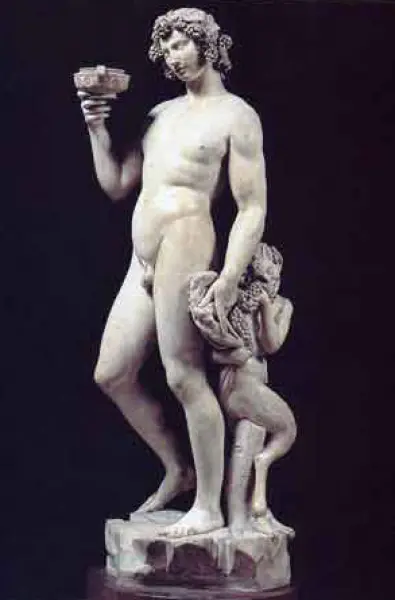Bacco
Durante il primo soggiorno a Roma il cardinal Riario chiese a Michelangelo una statua di Bacco. Ma una volta realizzata, la statua finì nel giardino del banchiere Jacopo Galli, altro protettore dell'artista, che, secondo una moda diffusa presso le famiglie più in vista di Roma, raccoglieva statue e frammenti antichi a formare un ricchissimo "antiquarium". Un'idea molto precisa di quell'impressionante collezione ci è offerta dai disegni cinquecenteschi che lo rappresentano, specialmente quelli del fiammingo Maarten van Heemskerk.
La statua, in marmo, alta 203 cm., compresa la base, oggi è conservata nel Museo nazionale del Bargello a Firenze.
Ai primi di luglio del 1496 Michelangelo, aveva già acquistato un blocco di marmo di Carrara e realizzò la statua nel giro di un anno.
L'opera rivela una padronanza assoluta dell'anatomia, dei mezzi tecnici, dei valori di composizione, armonia ed equilibrio classici, ma anche di sorprendente capacità inventiva, perché creata secondo la fantasia dell'artista, senza derivazione diretta. Una libertà immaginativa potente, sostenuta comunque da una solida conoscenza dell'antichità.
Il gruppo raffigura Bacco, ebbro e barcollante, affiancato da un satiro bambino che ride maliziosamente e morde l'uva di nascosto. Rappresenta lo splendido risultato dell'incontro dello scultore poco più che ventenne con l'onnipresente e maestosa bellezza dell'antico in Roma.
Michelangelo aveva già potuto conoscere frammenti antichi a Firenze nel giardino di San Marco e nei tesori medicei, a Pisa aveva potuto vedere gli antichi sarcofagi del Camposanto, ma a Roma l'antichità gli si offriva allo sguardo e allo studio con varietà e precisione: tanto che il Bacco, nell'accostarsi alla statuaria antica, risente particolarmente di certi tratti della scultura ellenistica.
Fatto per esser visto da più di un lato, il gruppo statuario articola un complesso rapporto spaziale tra il dio del vino e il suo piccolo accompagnatore, che lo avvicina furtivo da tergo.
Mentre Bacco incede col corpo carnoso e morbido proteso in avanti e sbilanciato, quasi inseguendo la coppa di vino che innalza a portata dello sguardo dilatato, il satiretto si torce in un ardito contrapposto che fa ruotare la metà superiore della figura di ben oltre novanta gradi rispetto alle gambe caprine.
Da qui deriva l'effetto dinamico: il senso di oscillazione, di instabilità, che suggerisce la camminata e il movimento tipici delle persone ubriache.
La lavorazione delle superfìci varia da parte a parte, con effetti di grana ruvida nel satiro, e di levigata politezza sull'epidermide del dio, di cui già le fonti notavano la mollezza effeminata, composta di tratti maschili e femminili.
A. Cocchi
Bacchus

Michelangelo Buonarroti. Bacchus. 1497. Marble. Florence, Museum of Bargello
During Michelangelo 's first stay in Rome, Cardinal Riario asked him a statue of Bacchus. However, once finished, the statue ended up in the garden of Jacopo Galli, a banker and benefactor of the artist, who, according to a trend among the most influential families of Rome, collected statues and antique pieces in order to form a rich "antiquarium". A very precise idea of that impressive collection is offered to us through drawings from the 1500s, especially those by the Flemish artist Maarten van Heemskerk.
The 203 metres high (including the base) marble statue is currently housed at the National Museum of Bargello, in Florence.
At the beginning of July 1496, Michelangelo had already bought a Carrara marble block, and subsequently concluded the statue in one year's time.
The work not only reveals a mastery of the body's anatomy, technique, of composition values, harmony and classical balance, but also a surprising inventive capacity, since it was created from Michelangelo's own powerful imagination, without direct diversion. It shows a powerful imaginative freedom, supported nevertheless by a solid knowledge of the antique. The group depicts Bacchus, inebriated and unsteady, next to a Satyr boy who mischievously smiles and secretly eats the grapes. It represents the extraordinary result of the encounter of the twenty something sculptor with the majestic and omnipresent beauty of ancient Rome.
Michelangelo had already been able to get in contact with antique pieces in Florence, i.e. in the garden of San Marco and among the Medici's treasures, and in Pisa he had seen Camposanto's ancient sarcophagi. But in Rome the antique was offered before his eyes and study with variety and precision: so much so that Bacchus, when moving around the antique statuary, shows particular traces of the Hellenistic sculpture.
Made in order to be seen from both angles, the statuary group articulates a complex spatial connection between the God of Wine and his little companion, who gets furtively closer from behind.
While Bacchus swaggers with his corpulent soft body angled and stretched forward, almost chasing the wine chalice he raises to his wide eyes, the little satyr twists boldly rotating the top half of his body almost ninety degrees in relation to his caprine legs.
The dynamic effect evolves from this: the sense of oscillation, instability, suggesting the walk and the moves typical of a drunken person.
The carving of the surface varies in each part of the statue, with a coarse grain effect for the satyr, and a polished effect for the skin of the God, where a certain effeminate weakness can be noticed, a composition of male and female traces.
A. Cocchi
Trad. A. Sturmer
Bibliografia:
E. Bernini, R. Rota Figura 1 Editori Laterza, Bari 2002
G. Cricco, F. Di teodoro Itinerario nell'arte. Vol 2, 2000
G.C. Argan, B. Contardi in: Michelangelo Dossier Art n. 9 Giunti, Firenze
C. Alchidini Luchinat, E. Capretti, K. Weil-Garris Brandt Michelangelo. Gli anni giovanili. Dossier Art n. 150 Giunti, Firenze


